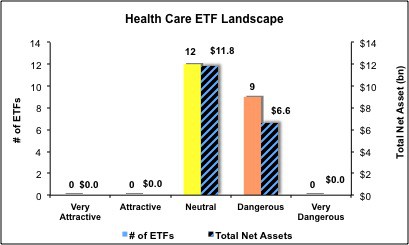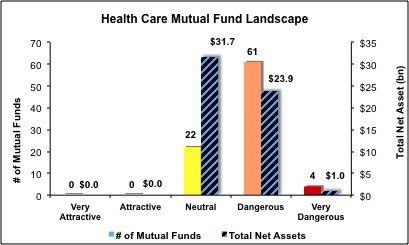The Health Care sector ranks fourth out of the ten sectors as detailed in my Sector Rankings for ETFs and Mutual Funds report. It gets my Neutral rating, which is based on aggregation of ratings of 21 ETFs and 87 mutual funds in the Health Care sector as of July 9, 2013. Prior reports on the best & worst ETFs and mutual funds in every sector and style are here.
Figures 1 and 2 show the five best and worst-rated ETFs and mutual funds in the sector. Not all Health Care sector ETFs and mutual funds are created equal. The number of holdings varies widely (from 20 to 292), which creates drastically different investment implications and ratings. The best ETFs and mutual funds allocate more value to Attractive-or-better-rated stocks than the worst ETFs and mutual funds, which allocate too much value to Neutral-or-worse-rated stocks.
To identify the best and avoid the worst ETFs and mutual funds within the Health Care sector, investors need a predictive rating based on (1) stocks ratings of the holdings and (2) the all-in expenses of each ETF and mutual fund. Investors need not rely on backward-looking ratings. My fund rating methodology is detailed here.
Investors should not buy any Health Care ETFs or mutual funds because none get an Attractive-or-better rating. If you must have exposure to this sector, you should buy a basket of Attractive-or-better rated stocks and avoid paying undeserved fund fees. Active management has a long history of not paying off.
Get my ratings on all ETFs and mutual funds in this sector on my free mutual fund and ETF screener.
Figure 1: ETFs with the Best & Worst Ratings – Top 5
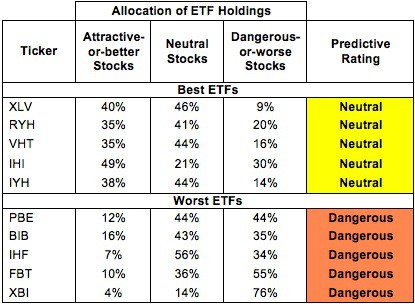
Sources: New Constructs, LLC and company filings
Figure 2: Mutual Funds with the Best & Worst Ratings – Top 5
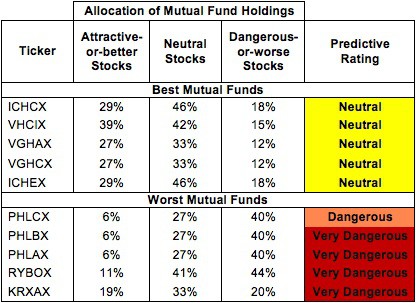
Sources: New Constructs, LLC and company filings
Live Oak Health Sciences Fund (LOGSX) and Saratoga Advantage Health & Biotechnology Portfolio (SBHIX) are excluded from Figure 2 because their total net assets (TNA) are below $100 million and do not meet our liquidity standards.
Health Care Select Sector SPDR (XLV) is my top-rated Health Care ETF and ICON Healthcare Fund (ICHCX) is my top-rated Health Care mutual fund. Both earn my Neutral rating.
SPDR S&P Biotech ETF (XBI) is my worst rated Health Care ETF and Kinetics Mutual Funds Medical Fund (KRXAX) is my worst rated Health Care mutual fund. XBI earns my Dangerous rating, while KRXAX earns my Very Dangerous rating.
Figure 3 shows that 48 out of the 325 stocks (over 30% of the market value) in Health Care ETFs and mutual funds get an Attractive-or-better rating. However, no Health Care ETFs or mutual funds get an Attractive-or-better rating.
The takeaways are: mutual fund managers allocate too much capital to low-quality stocks and Health Care ETFs hold poor quality stocks.
Figure 3: Health care Sector Landscape For ETFs, Mutual Funds & Stocks
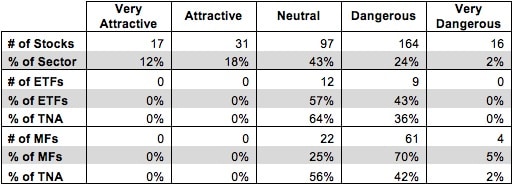
As detailed in “Low-Cost Funds Dupe Investors”, the fund industry offers many cheap funds but very few funds with high-quality stocks, or with what I call good portfolio management.
Investors need to tread carefully when considering Health Care ETFs and mutual funds, as no funds receive an attractive or better rating. Focus on individual stocks instead.
Amgen (AMGN) is one of my favorite stocks held by Health Care ETFs and mutual funds and earns my Very Attractive rating. Amgen has grown after-tax profit (NOPAT) by 15% compounded annually since 1998. It also boasts a return on invested capital (ROIC) of 18%, putting it in the top quintile of all companies I cover, and healthy NOPAT margins of over 30%. Moreover, AMGN has increased economic earnings every year since the beginning of my model in 1998. Even though Amgen has such an impressive track record of profitability, it’s surprisingly cheap. At its current valuation of ~$98.18/share, AMGN has a price to economic book value ratio of 0.8, implying that the market expects its NOPAT to permanently decline by 20%. Given AMGN’s high margins and strong history of growth, such a pessimistic expectation seems unwarranted.
Hospira Inc. (HSP) is one of my least favorite stocks held by Health Care ETFs and mutual funds and earns my Very Dangerous rating. Over the past eight years, HSP’s NOPAT is practically unchanged, growing by an average of less than 1% a year compounded annually. On the balance sheet, HSP’s liabilities, including debt, underfunded pensions, and outstanding employee stock options, total over $2.2 billion, or over six times its free cash flow from 2012.
HSP’s current valuation of ~$38.47/share implies 11% NOPAT growth compounded annually for 10 years. Such high expectations embedded in the share price should make investors think twice about almost any company, especially one with as unimpressive a track record as HSP.
376 stocks of the 3000+ I cover are classified as Health Care stocks, but due to style drift, Health Care ETFs and mutual funds hold 325 stocks.
Figures 4 and 5 show the rating landscape of all Health Care ETFs and mutual funds.
My Sector Rankings for ETFs and Mutual Funds report ranks all sectors and highlights those that offer the best investments.
Figure 4: Separating the Best ETFs From the Worst ETFs
Figure 5: Separating the Best Mutual Funds From the Worst Mutual Funds
Review my full list of ratings and rankings along with reports on all 21 ETFs and 87 mutual funds in the health care sector.
André Rouillard and Sam McBride Contributed to this report.
Disclosure: David Trainer, André Rouillard and Sam McBride receive no compensation to write about any specific stock, sector or theme.
